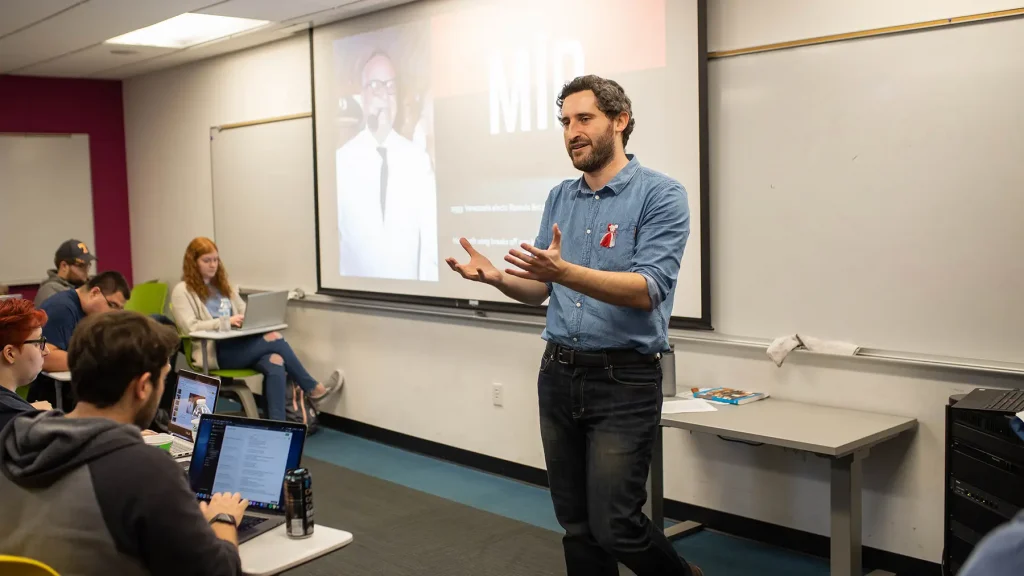New UT Program Bridges Social and Natural Sciences

Interdisciplinary programs offer students an insightful and competitive edge in critical thinking by making strategic connections outside of traditional study boxes. One of the newest such programs in the UT College of Arts and Sciences spotlights the human element within the future of digital interaction.
The new minor in Science, Technology, Health, and Society (STHS) bridges topics across social and natural sciences to broaden the view of Vols studying in any major.
“Those studying engineering, natural, mathematical, health sciences should be able to place their practice in a social context,” said Associate Professor of History Victor Petrov, program director. “While all humanities scholars and social scientists these days must grapple with questions about the effect of science on policy, society, economics, and our cultures and ethics more broadly. This new program brings many different disciplines into the conversation.”
Interdisciplinary Community
The program draws on the expertise of faculty scholars exploring questions in natural sciences and their colleagues in the humanities and social sciences who examine the social construction of science and its consequences.
“It is an obvious advantage to bring these scholars into a community, rather than working just in our respective departments,” said Petrov. “It lets students know about such work and make connections.”
Science, Technology, Health, and Society works in tandem with closely related digital futures programs—Digital Humanities and Computational Social Science. All three grapple with society’s technological methods and what it means to visualize data and most efficiently digitize information. STHS deals more specifically with how science, technology, and medicine are socially constructed, and how they impact our societies, politics, and cultures.
“There is an old joke: Fish don’t really know what water is,” said Petrov. “Scientists, engineers, and doctors are immersed in their technical areas. This new program draws attention to the water they swim in—what is the environment that even enables scientists, doctors, and technical experts to do their work.”
Valuable Connections
Students diving into Science, Technology, Health, and Society will be introduced to topics like what makes someone a scientist; how does a laboratory function; medical activism; company structures and the impact of technology on labor; and how is infrastructure built and maintained.
“Courses range widely from AI’s ethics and development to topics in the evolutionary and ecological sciences,” said Petrov. “Geographic information science and its human dimensions; arms control and nuclear proliferation; the impact of data on society; philosophy of science or the mind; the history of health in Africa; space exploration. I can list numerous topics, which is precisely the point.”
Students interested in STHS might find that they are already taking classes that are part of the minor—engineering, agricultural science, history, geography. With courses originating from both the social and natural sciences, the STHS minor fits easily alongside most majors.
“You have to think about science and technology’s impact on society if you are a humanities scholar; and you have to think about the social consequences of your scientific work,” said Petrov. “You are asking these questions anyway, so this program is the perfect way to explore them fully in addition to other interests.”
Enhanced Career Paths
The program’s interdisciplinary blend adds a robust layer of thoughtfulness to careers across science, and even business or law. The introductory class alone addresses issues in technology, science, and health, from medical policy and ethics to infrastructure construction to laboratory practice, and more.
“Science, Technology, Health, and Society can lead to careers in public policy, work in various areas of business, law, engineering, to academia, science journalism, or public service,” said Petrov.
The program also ensures opportunities for UT students to study these fields here at Rocky Top—gaining skills applicable to the region’s rich technical industry.
“UT’s proximity to Oak Ridge is another obvious advantage—a Science, Technology, Health, and Society program is a great thing to have with such close ties to a major part of technological history,” said Petrov. “It shows prospective students and scholars that we, too, are working in this relevant and cutting-edge intersection of science and society.”
By Randall Brown